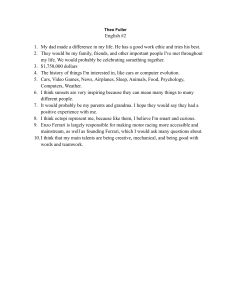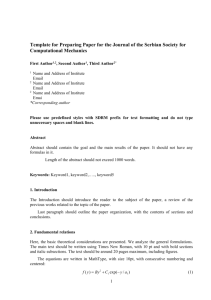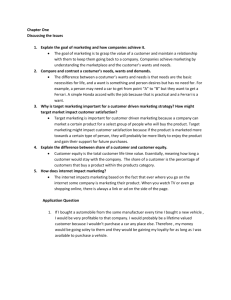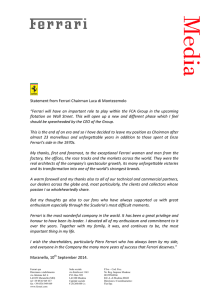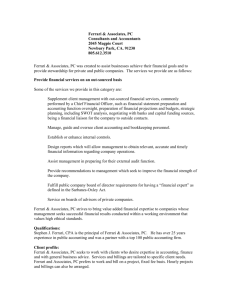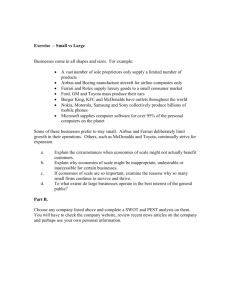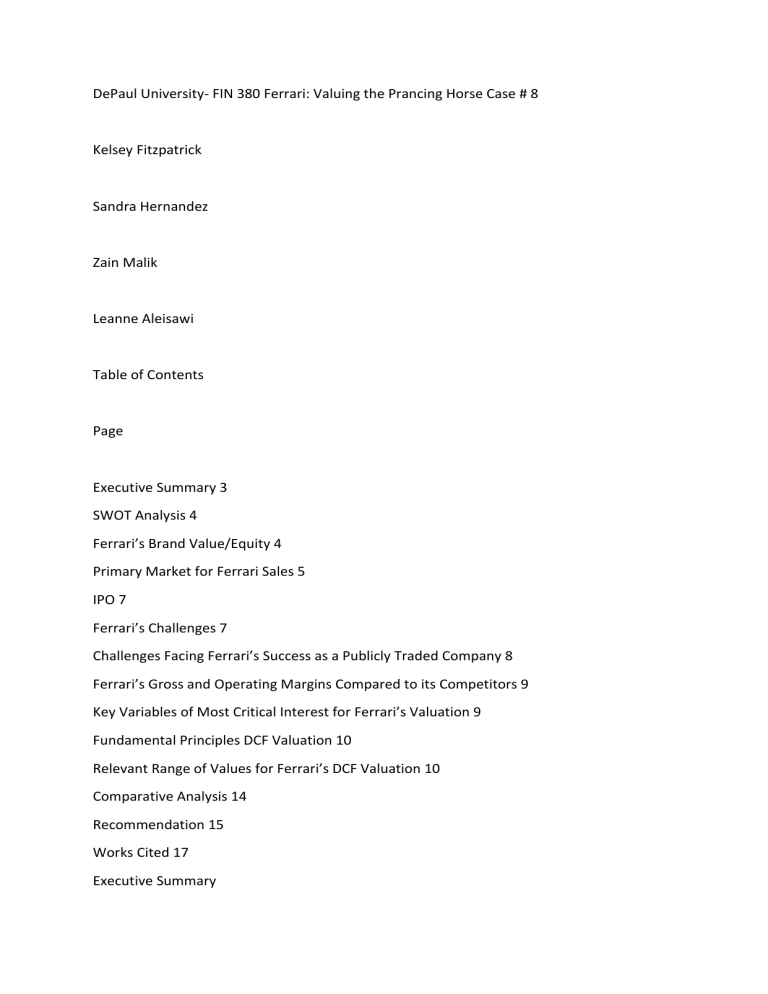
DePaul University- FIN 380 Ferrari: Valuing the Prancing Horse Case # 8 Kelsey Fitzpatrick Sandra Hernandez Zain Malik Leanne Aleisawi Table of Contents Page Executive Summary 3 SWOT Analysis 4 Ferrari’s Brand Value/Equity 4 Primary Market for Ferrari Sales 5 IPO 7 Ferrari’s Challenges 7 Challenges Facing Ferrari’s Success as a Publicly Traded Company 8 Ferrari’s Gross and Operating Margins Compared to its Competitors 9 Key Variables of Most Critical Interest for Ferrari’s Valuation 9 Fundamental Principles DCF Valuation 10 Relevant Range of Values for Ferrari’s DCF Valuation 10 Comparative Analysis 14 Recommendation 15 Works Cited 17 Executive Summary FerrariEnzo , an he Italian automotive engineer, worked for years with Alfa Romeo as the director of the Alfa Corse racing division. brandsinnovationperformanceIn 1939, Enzo left Alfa Romeo after deciding to start up his own firm. Later on, Ferrari was founded in 1947 which became known for its world-class Sports Car Manufacturing. It is one of the world’s leading luxury . The brand symbolizes , Italian design and engineering heritage, exclusivity, and state-of-the-art sporting . The company is closely associated with Formula 1 racing team, Scuderia Ferrari. Since 1950 the team has won 224 Grand Prix races, 16 Constructor World titles, and 15 Drivers’ World titles and over 5,000 races worldwide. marketsToday, Ferrari designs and produces the cars in Maranello, Italy, and sells it in more than 60 globally. SWOT Analysis Ferrari’s Brand Value/Equity Brand equity refers to the importance of a brand in the customer's eyes, while brand value is the financial significance the brand carries. In other words, intangible assets. Both brand equity and brand value are educated estimates of how much a brand is worth. The art behind Ferrari and its powerful stature in the market, is driven by its brand value and brand equity as they both go hand in hand in their case. Though consumer loyalty and racing heritage are two key drivers to Ferrari’s brand equity, since Ferrari is a luxury item it can be difficult to turn its logo and unique background into monetary value. In a cost-based brand valuation (2013), we consider the value of anything that consumers associate with your brand and image, such as your trademark, brand name, visual assets such as a logo or colors, unique marketing strategy, digital assets or licenses, and level of customer loyalty. Exhibit 2 in 2013 states sponsorship, commercial, and brand as 17.6% of sales revenue (€412m or $458,520,980). In Appendix 2 in 2013, intangible assets (including trademarks, copyright, etc) at € 242,167 ($269511.29) and goodwill at €787,178 ($875,668.61) pricing their brand at a total of $459,666,160. A low-volume production strategy pursued by the company maintains its reputation for exclusivity and scarcity. Ferrari was considered the world’s most powerful brand, but not necessarily the most valuable. ● Consumer loyalty ● Pricing power ● Racing heritage ● Development and production ● Financial performance and profile ● Exclusivity Can Ferrari propose a dividend? One way Ferrari could maintain the exclusivity of its value is to propose a dividend payout to its shareholders in substitute for any lack of growth in the company. In Exhibit 7 Ferrari’s Market Value in Multiples, Ferrari shares the same Price per Earnings in the year of 2016. While Hermes pays a 1% dividend, Ferrari pays 0% with a lower price to sales ratio yet higher price share. According to the dividend discount model, a dividend payout of $5 per share at a 1% dividend yield, price share would increase to $50 per share becoming more competitive in the market and increasing value in the company’s stock. 5/.1=$50 Why go public? Since Ferrari was such an “eye candy” in the auto market, Ferrari saw the opportunity to increase both value and earnings to compensate existing owners, ei. Fiat. Their first move after going public was not to reinvest shares but to increase their leverage. There is a possibility that Ferrari forecasted a default due to low production and exclusivity. Primary Market for Ferrari Sales strategy targeting target Ferrari has positioned itself as a luxury sports car Maker Company closely associated with some of the renowned racing events worldwide. The brand uses value-based positioned to provide the owner a sense of pride of owning such a luxurious car. That being said, the brand uses selective since the company doesn’t want everyone to own the brand (due to the value and power it provides a person through its core pillars), therefore, it does a background check and its customers are the famous personalities, celebrities globally and wealthy people. Hence, the premium and luxury products are targeted to the customers who value the essence of the brand and associate themselves with the persona of the brand. The customers of the brand Ferrari are very rich and wellknown personalities of the world who themselves are the celebrities and want to have some exclusive luxury sports car. Ferrari’s Challenges ● Ferrari had great margins (45.5% Gross Margin more than double any other automobile company) however, the challenge that arises is whether they can maintain such margins or not. ● Small product portfolio which means less diversification which can be a problem ● It is a powerful brand but not most valuable ● Low volume strategy (limited growth) - such business model eliminates the possibility of employing certain technological solutions and limits their sales volumes even if demand was high. That being said, because they are classified as a small volume manufacturer, they are subject to less stringent emission requirements both in the U.S (because they sell less than 10,000 units globally) and the EU which limits their ability to grow. ● They also have a “waiting list” policy, which might make them lose customers to other competitors. ● A big challenge is fuel efficiency and emissions which are growing in importance everyday. ● Automotive industry is considered to be a cyclical industry meaning it's sensitive to the business cycle. IPO An initial public offering (IPO) is the process of offering shares of a private corporation to the public in a new stock issuance. Public share issuance allows a company to raise capital from public investors. A company planning an IPO will typically select an underwriter or underwriters. They will also pick an exchange in which the shares will be issued and then traded publicly. Before an IPO, a company is usually considered private. As a private company, the business expanded with a relatively small number of shareholders which includes investors, founders, etc. An IPO provides the company with access to raising a lot of money. This gives the company a greater ability to grow and expand. On October 20, 2015, Ferrari’s IPO was a success. Advantages of an IPO ● The company gets access to investment from the entire investing public to raise capital. ● Facilitates easier acquisition deals (share conversions). ● Increased transparency that comes with required quarterly reporting can usually help a company receive more favorable credit borrowing terms than as a private company. ● secondary offerings A public company can raise additional funds in the future through because it already has access to the public markets through the IPO. ● Public companies can attract and retain better management and skilled employees through liquid stock equity participation (e.g. ESOPs). ● cost of capitalIPOs can give a company a lower for both equity and debt. ● Increase the company’s exposure, prestige, and public image, which can help the company’s sales and profits. Challenges Facing Ferrari’s Success as a Publicly Traded Company ● Promised earnings in the company ● Exclusivity - no dividend offered ● Profitability to drive share price Ferrari’s aim was to achieve profitable growth by pursuing ‘controlled growth in developed and emerging markets’. One of the drawbacks associated with going public was that the capital raised was not targeted at reinvestment into the business, but to compensate existing owner, Fiat, for reducing its interest. Ferrari also had no plans to offer dividends, so its value proposition relied exclusively on hoped-for capital gains. Investors would expect double-digit rates of return. Fundamental factors drive stock prices based on a company's earnings and profitability from producing and selling goods and services. Profitability is driven by increased turnovers, productivity and efficiency. Ferrari’s Gross and Operating Margins Compared to its Competitors In the examination of Ferrari finances, a few numbers stand out. First, the Ferrari portfolio consisted of eight vehicles in their product portfolio. Compared to other automakers, a portfolio of eight cars is relatively small. Though Ferrari had only eight vehicles in their product portfolio, it accounted for 70% of total revenue generation. Also, the financial statements showed the extremely high spending on Research and Development that Ferrari engages in. Ferrari research and development in terms of percentage of sales was 20%, whereas other automakers such as the luxury car brand Porsche averaged around 11%. The global automaker industry typically averages 5% on research and development. Another point that stands out in Ferrari finances is the “Silicon Valley” level of gross margin. Due to the luxury automaker's desire to have first class pricing long with a minimalist approach to the cost structure, the gross margin is specially astronomical. For example, Volkswagen, General Motors, and Toyota have a gross margins of 18.0%, 11.4%, and 22.2% respectively. Ferrari stands out at an outstanding gross margin percentage of 45.5%, more than doubled of any global automaker. Due to such a large gross margin, the operating margin is also high for Ferrari. On top of having the highest gross margin in the industry, Ferrari holds the highest operating margin as well which sits at 14.1%. Between the two margins (operating margin and gross margin), there was a 31%. With the combination of small product portfolio, high spending in research and development, and need to have a premium pricing with minimalist cost structure has led to Ferrari being able to achieve high gross and operating margins. Key Variables of Most Critical Interest for Ferrari’s Valuation When looking at Ferrari valuation, certain critical factors should be looked into. One of these critical factors is volume growth. Ferrari strategy involves low production of automobiles due to the company desire to be exclusive and uncommon. From 1997-2014, the automaker averaged around 4.4% growth per year. Compared to other automakers, a growth rate of 4.4% Is very small. In terms of scarcity, it has had positive and negative effects for Ferrari. The positive was that the High Net Individuals who are the focus for Ferrari has grown 8.6% per year however on the flip side, a 4.4% growth rate is not very promising if sales and earnings did not keep up with the rate of vehicles produced. Outside of volume growth, R&D is another component to look out for during valuation. Ferrari spends a massive amount of money on the research and development department. Most automakers average around 5% but Ferrari sits at 20% for R&D expenses as percentage of sales. Cost of capital is another factor to keep a lookout for during Ferrari valuation because it provides information on the amount necessary for specific investment growth. These are certain factors that should be considered when doing valuation for Ferrari. Fundamental Principles DCF Valuation The fundamental principles of a Discounted Cash Flow Valuation are to value a company based on the cash flows it will create in the future. This will, in turn, create value for the shareholders. An investor takes on the risk of purchasing shares of a company in hopes that their value will increase in the future. The value of future cash flows calculate to the present value of the company today. The DCF valuation uses a discount percentage known as the WACC to discount the future cash flows to bring them to present value. Relevant Range of Values for Ferrari’s DCF Valuation https://maildepaulmy.sharepoint.com/:x:/g/personal/sherna69_mail_depaul_edu/EaRF8XC_UEFNuPS3UX8Ux0B2PK1Xy0Mfe5Jg-zoafc8nw?e=FVo7jS In all scenarios, Ferrari maintains their above average margins. This is due to their low production and extremely high costs for their vehicles. While it may be of benefit to themselves as a private company, the shareholders who invest in their equity will be expecting a return on their investment in the long run. Downside Scenario NPV: $7,971 MM ($8B) Price per share: $39.21 Sales Volume growth: 3% Price growth: 1% Revenues Engine sales to Maserati and rentals: 2% Sponsorship, commercial, and brand: 2% Other F1 and financial income: 1% Costs COS: 3% SG&A: 4% R&D: 3% CAPEX: 2% Margins at Y2025 Gross: 57.1% EBIT: 30.2% Base Scenario (as mentioned in the case) NPV: $11,148 MM ($11B) Price per share: $56.02 Sales Volume growth: 4.4% Price growth: 2% Revenues Engine sales to Maserati and rentals: 3% Sponsorship, commercial, and brand: 3% Other F1 and financial income: 1% Costs COS: 2% SG&A: 2% R&D: 2% Margins at Y2025 Gross: 61.8% EBIT: 40.4% Upside Scenario NPV: $12,610 MM ($12.6B) Price per share: $63.75 Sales Volume growth: 6% Price growth: 4% Revenues Engine sales to Maserati and rentals: 4% Sponsorship, commercial, and brand: 4% Other F1 and financial income: 4% Costs COS: 1% SG&A: 1% R&D: 2% Margins at Y2025 Gross: 64.5% EBIT: 44% Comparative Analysis Multiples Price- to Earnings (P/E): As shown on Exhibit 7 in the case study, dated January 21, 2016 Consensus 2016 EPS est: $1.86 → $34.97 PPS* 189 shares outstanding= $6,609 MM ($6.6B) Valuation Using the current Price- to- Earnings multiple, the estimated share price is similar to the share price given by the discounted cash flows. This is due to Ferrari being seen as a value company, hence the high valuation multiple. When using the forward earnings, however, we get a completely different target share price of $34.97. This target price is a more realistic value of each share of equity by basing off their future earnings per share as according to consensus of analysts covering this IPO. The forward P/E ratio is more realistic because it is not basing the value of the stock off of luxury appeal but rather by actual potential earnings. EV to EBITA (EV/EBITA): As shown on Exhibit 8 in the case study, Ferrari’s multiple (EV/EBITDA) compared to other European luxury brands Comparative multiple: Ferrari: 11.4x, Group average: 12.1x 2016 consensus EBITDA est: $880 MM European Luxury Peers Average (12.1x) → (($880*12.1x)/189) = $56.34 price per share → $56.34 PPS* 189 shares outstanding= $10,648 MM ($10.6B) Valuation Ferrari (11.4x) → (($880*11.4x)/189)= $53.08 price per share → $53.08 PPS* 189 shares outstanding= $10,032 MM ($10B) Valuation When valuing Ferrari as a luxury brand as opposed to an automobile maker, the valuation of each price per share is similar to the target price given by the baseline discounted cash flow analysis. This shows that the company is valuing itself as luxury rather than as an automotive stock. While this may certainly bring investors, they will eventually realize that this stock was purchased more as “equity eye candy”. Unless the company begins to mass produce like other automobile makers, or at least increase their production significantly, they will not be seeing a good return on their investment. Recommendation ● Increase their product line maybe by manufacturing electric cars. This will help save the economy (eliminates the regulatory limitations of emission and mileage). Sales of plug-in electric vehicles grew by 79 percent between 2017 and 2018. That being said, electric cars are slowly taking over the market so it would be a smart move for Ferrari to consider adding electric cars to their product line with their unique and powerful brand. Also competitors like Lamborghini and Porsche are expanding their product range to high performance SUV’s wherein Porsche has already been very successful with its “Cayenne” model, all over the world. ● amusement parkYas IslandAbu DhabiUnited Arab EmiratesFerrarispace frameFerrari World is an on in , . It officially opened in November 2010. It is the first -branded theme park and has the record for the largest structure ever built. Ferrari World opened in the Middle East which only comprises 8.44% of its unit sales. That being said, possibly opening another location in a different country with a bigger population can possibly provide Ferrari with a different source of income, plus it would be a good publicity of the Ferrari brand by reaching out to a bigger consumer. Works Cited Bhasin, Hitesh. “Marketing Strategy of Ferrari - Ferrari Marketing Strategy.” Marketing91, 21 Mar. 2018, www.marketing91.com/marketing-strategy-ferrari/.
